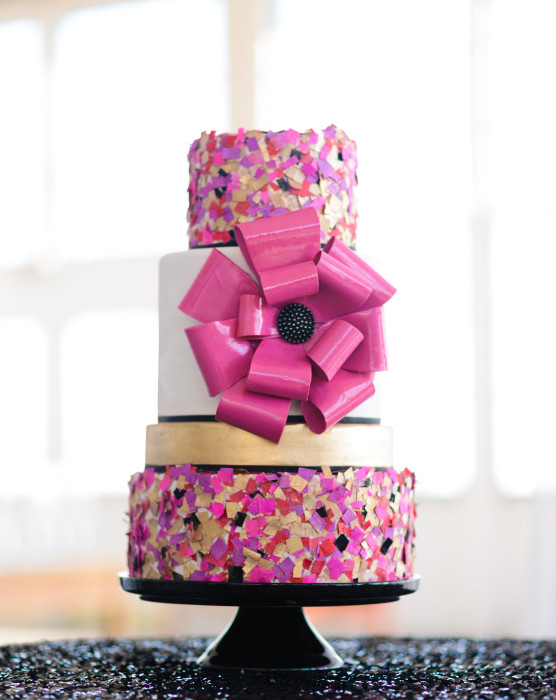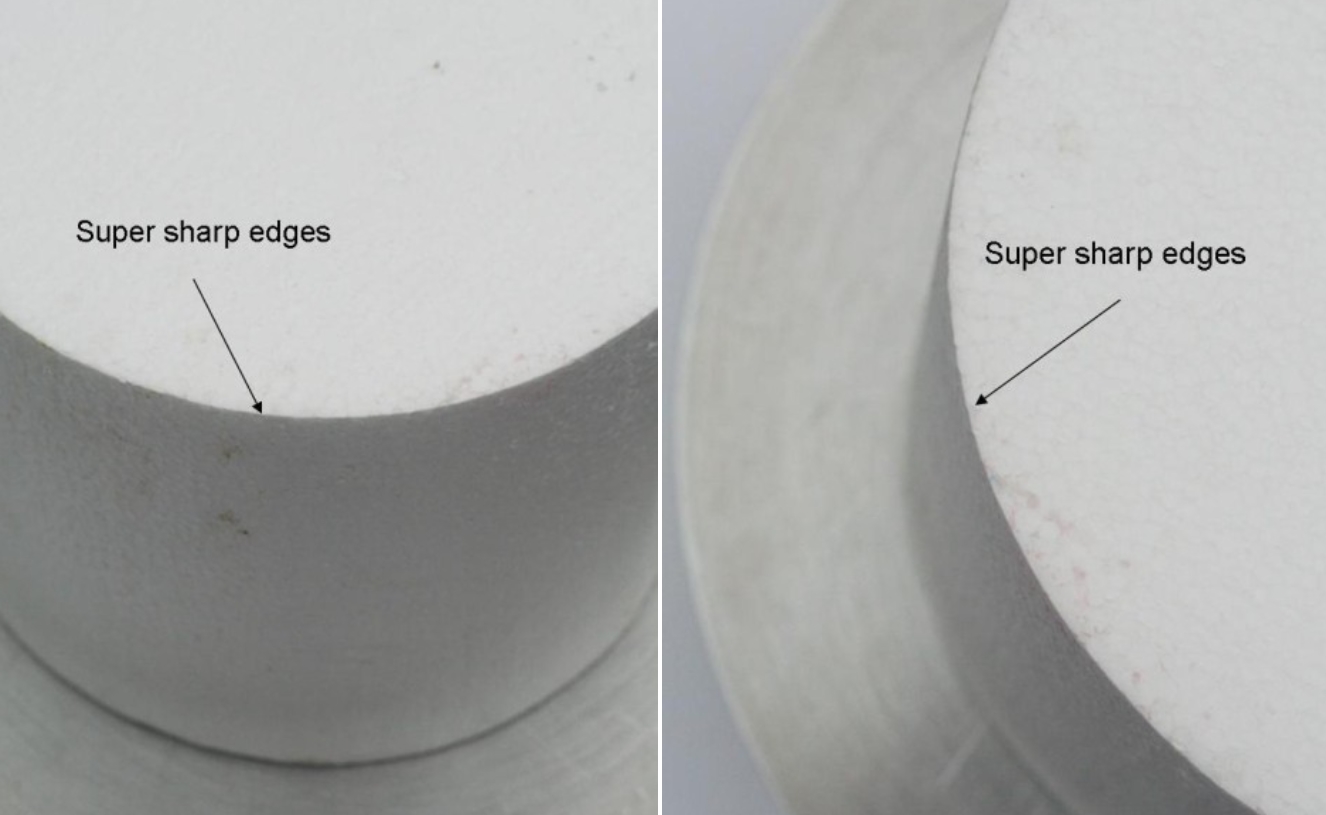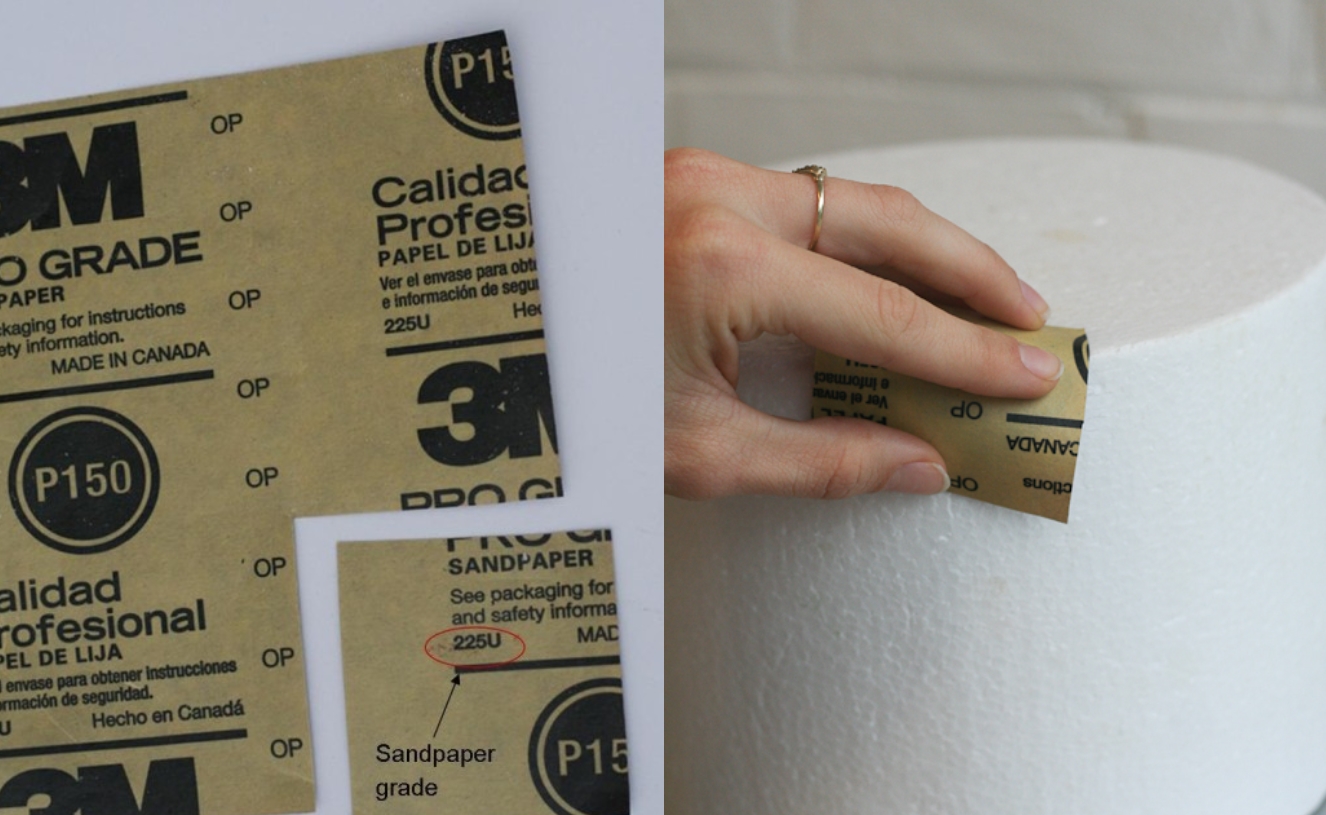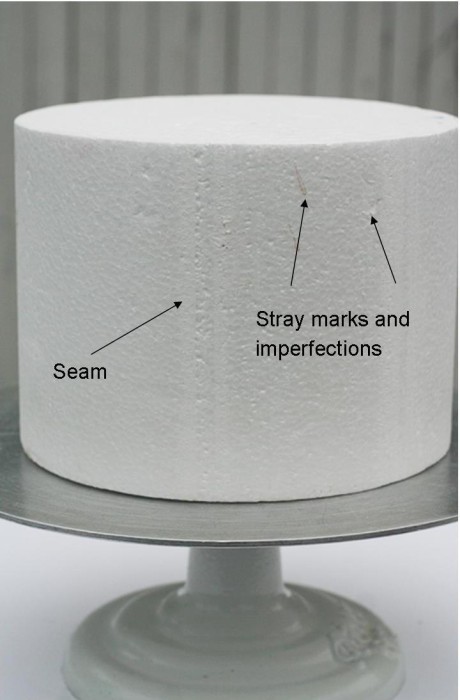You know how you sometimes pass your local bakery and think, “That cake’s been in the window for 15 years! How’d they do that?” Well, they’re using dummy cakes, also called faux or fake cakes. Dummy cakes are styrofoam forms cut into the shape of cake tiers and covered with either icing (buttercream or royal) or fondant.
We use dummies a lot for photo shoots (when no one is going to be eating the cake), for tiers that are shorter than standard height (when a slice of real cake the same height would look odd and skimpy on the plate), and for brides who have their heart set, for example, on a five-tier cake that would serve 200 guests (when they’re only having 100). Occasionally we get requests from brides who want to purchase only a faux cake for display purposes but plan to serve a cake bought elsewhere. Since we’re real sticklers for quality ingredients, pretty controlling, and don’t want our name associated with a cake someone else made, we politely decline. Our hard-earned reputation is on the line! We find that, while disappointed, people are very understanding of our position on the matter.
The 2″ tall gold tier in our confetti cake below was a faux tier.

Covering a dummy cake with fondant is not all that hard if you’re already comfortable covering real cakes, but there are a few tips that make the job easier. We’re sharing them here.
Materials Needed:
- fondant (we use Satin Ice)
- cake dummies in the size and shape of your choosing
- fine grade sandpaper (150 or higher)
- Crisco (vegetable fat)
- fondant smoothers (we prefer the PME smoothers)
- quality turntable (we like the Ateco 612 or 613)
1. Sand the edges. Cake dummies’ edges can be quite sharp, and because they’re not soft and malleable like buttercream- or ganache-covered cakes, have a tendency to tear fondant. Here is our “before” dummy.

To prevent tearing, we use fine-grade sandpaper to gently take the sharp edge off our dummies. We’re not trying to bevel the edges, just round them ever so slightly. Confused about sandpaper grades? Here’s your sandpaper primer.
Sandpaper Primer by Erica OBrien Cake Design
Sandpaper grades can be confusing because the smaller (i.e, finer) the grains of grit (sand), the bigger (higher) the sandpaper grade. But sandpaper grade actually measures the number of particles that would fit within a given space, not the size of each particle. Think of it this way: If you had a one-inch square, the LARGER the particles of grit were, the FEWER particles would fit within the square centimeter. Since we’re counting particles, this sandpaper would have a lower grade, such as 100 or even 60 or 50. Low grade sandpapers, with their big particles, tend to be very rough. The opposite is also true: the SMALLER the particles, the MORE fit in your square inch, so the grade would be higher–say 220 or 320, all the way up to 1000–and the particles will be smaller than 50 grade sandpaper.
To sand your edges, cut a small piece of fine-grade sandpaper, 220 or higher. Gently press and move back and forth on your edge until the sharpness is removed. Here, we used 225-grade.

2. Sand the sides if needed. I usually purchase my dummies from Guildcraft. They manufacture furniture, and dummies are one of their byproducts. They ship very fast (albeit expensively) and will cut your dummy to any height (they call it “thickness”) you request. However, they’re furniture experts, not cake experts, and I’ve gotten dummies from that have protruding seams, rough patches, or other imperfections that would be visible through fondant. For these imperfections, you should again use fine-grade sandpaper and sand until smooth. (I’ve gotten into the habit of reminding Guildcraft at the time I place my order that I need the dummies perfectly smooth and they’re generally pretty good about sanding them for me.)


3. Slather on the Crisco. Yup. I said slather. I’m generally not a slatherer, but the Crisco serves two purposes. First, it fills any cracks, crevices, or indentations that your fondant would otherwise sink into. Second, the Crisco is what adheres the fondant to the dummy. I used to use water, but found that the water evaporated too quickly by the time I’d rolled my fondant out to secure the fondant to the dummy. Crisco is sticky enough to adhere it but slide-y enough to allow some movement. It’s the perfect medium for this purpose.
4. Wipe away the excess. Once you’ve slathered it on, wipe off the excess Crisco so that only a very thin layer remains. Avoid leaving globs of extra Crisco as this will be absorbed by the fondant and make it soft and stretchy. We’re just looking for a thin coating. Your dummy is now ready for covering.
5. Cover and cut out the center of all tiers but the top. I’ve said many times that I’m frugal. Okay, I’m a major cheap ass. That’s why, when I’m doing a tiered cake and no one is going to see the center of the tiers where the subsequent tiers are stacked atop them, I cut out the fondant. My theory (and the way I justify it) is that it speeds the drying of the fondant by allowing more are to circulate. And, since I’m not worried about keeping a real cake insulated and fresh, it has no impact on the cake. But the truth is, I’m as cheap as they get, and so I try not to waste product whenever I can. Feel free to judge.
5. Know that dummies will dry faster than real cakes. The moisture in real cakes (from butter, milk, water, etc.) will be absorbed by the fondant, keeping the fondant soft and pliable. Because there is no moisture in a dummy cake, the fondant will dry faster. As the fondant dries (and the moisture content in the fondant evaporates), the fondant will shrink slightly. Hopefully the shrinking won’t be visible, but if you notice that the bottom edge of your fondant shrinks away, revealing some of the dummy, this is why. Be aware of the possibility of “shrinkage” when covering a dummy, and have a plan in place for correcting your fondant should this happen. The dummies below suffered some shrinkage around the bottom edge.
Have some other tricks or tips for covering dummies? Please leave a comment! We would love to hear them. Best of luck!
Comment on “How to Cover a Dummy Cake”
tamanya
This I so helpful and a great tutorial. Thank you. However I was wondering the dumies are so light how do I keep them from being blown by the wind on the wedding day it’s on the ground
Erica OBrien
The fondant weighs them down, and I glue them together with styrofoam glue. If you’re concerned, glue or tape the underside of the bottom tier to a heavy-duty cake stand.
tamanya
This I so helpful and a great tutorial. Thank you. However I was wondering the dumies are so light how do I keep them being blown by the wind on the wedding day it’s on the ground
Erica OBrien
The fondant definitely adds weight, but you could glue them with styrofoam glue or tape them with heavy duty duct tape to a board if you’re concerned.
Corie Bosworth
How do you attach the layers to each other, just like a normal cake?
Erica OBrien
Sort of. You don’t need to support them with dowels. I usually just moisten the part of the fondant that will be in contact with the tier above it with water, being careful not to drip anywhere that will be seen. The sticky fondant will keep the Styrofoam in place.
Talara
Can I frost a dummy cake using buttercream frosting? If so what is the process?
Erica OBrien
I have done this but find it difficult. Cut a piece of foamcore about 1/2″ larger than your dummy, so if you have a 6″ round dummy you’ll need a 6 1/2″ round board. (The easiest way to cut perfect circles is with the Martha Stewart circle cutter: http://amzn.to/1IxnQfE. Secure the board to the bottom of your dummy so it gives you a space to fill in with buttercream. The trickiest part is that the dummy is so lightweight. You’ll need to secure it to your worktable so it doesn’t get moved around.
Good luck!
Kelli Cake Diva
I’m getting ready to try this…making my brother’s wedding cake and I’m making 2 of the 3 tiers “dummy” cakes. I’ve attempted 5 times now, and EVERY 1 tears! Uuuuugh! Sooo hoping this works! Fingers crossed!!
Erica OBrien
I’m sure it will work this time! Good luck!
Barb Matias
Thank you all. This post has been very helpful. I have made cakes for 40 years but never used a dummy. I wasn’t sure how to start.

